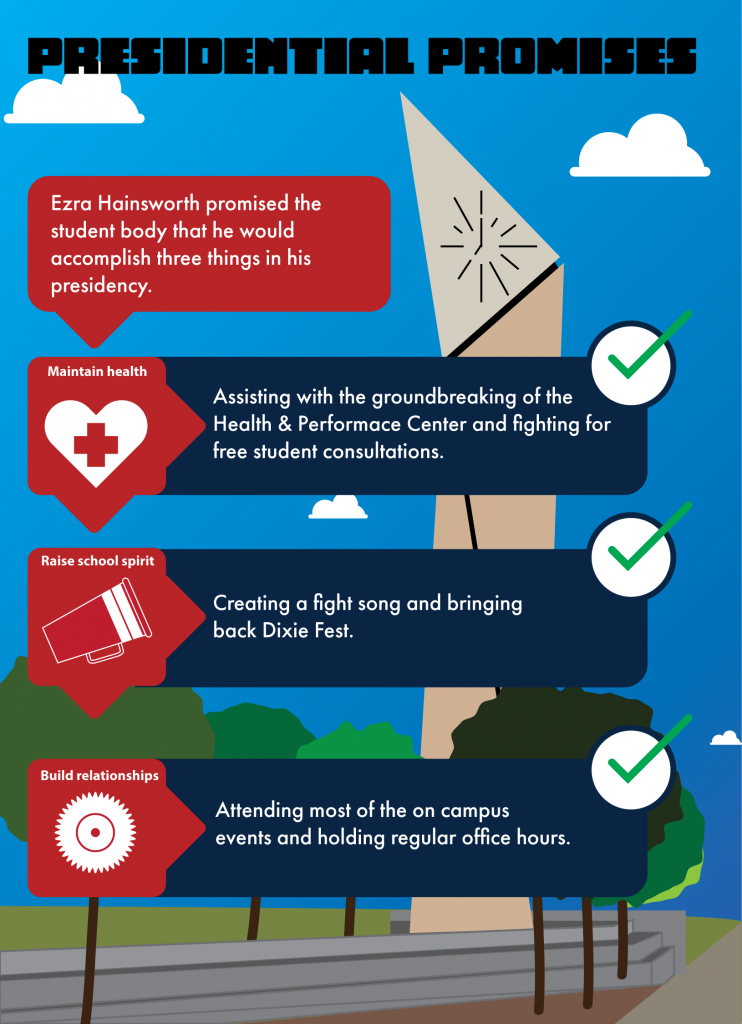The Dixie State University board of trustees held its first meeting of the year to discuss enrollment, expansion of campus, faculty and staff representation, and policies.
The board of trustees, led by chair David Clark, opened the general session of the meeting by swearing in new trustees Lindsay Atwood, Ezra Hainsworth and Tiffany Wilson.
Clark also introduced new faculty and staff, including Eliezer Bermudez, the new dean of the College of Health Sciences, Jamy Dahle, counselor and outreach coordinator at the Health and Counseling Center, Jeffery Hoyt, assistant vice president for student success and co-curricular assessment, Kelly Peterson-Fairchild, dean of the library and learning services, Jeff Yule, director of the honors program, and Pam Cantrell, interim director of graduate studies.
Each new faculty and staff member gave a short introduction and talked about his or her programs.
President Richard B. Williams gave his report and recognized the work that goes into beginning a new academic year, as well as maintenance of facilities over the summer. He reported on-campus student housing is full, and sales at the bookstore and Trailblazer Café are record high. Williams also reported on the progress of the Human Performance Center and mentioned high need for the Science, Engineering, and Technology Building as ranked by the board of regents.
Peter Gitau, vice president of student affairs, and Darlene Dilley, assistant vice president of enrollment management, gave an enrollment report on current enrollment rates and the freshman class profile as well as future plans for recruitment.
At 9,700 students, enrollment has increased by 7 percent since last year, and it is the biggest Freshman class in the history of DSU. Gitau said many schools nationwide are experiencing enrollment declines, so DSU is doing comparatively well.
“We’re not just shooting for anybody,” Gitau said. “We really are looking for students that will be successful at the university.”
Most—about 72 percent—of the freshman class is from Utah, while 28 percent come from out of state or other countries. Washington County high schools comprise the top five feeder schools, Dilley said. She pointed out the top 10 of 33 out of state locations where DSU students are from: Nevada, California, Idaho, Arizona, Hawaii, Wyoming, Colorado, Washington, Texas and Alaska.
Dilley announced DSU will begin implementing a $100 registration deposit to be subtracted from tuition. This deposit, she said, will help reduce melt, which refers to students who commit by registering but end up not enrolling. Dilley made it clear that it would be a deposit, not an added fee.
She reported DSU has decided to continue its partnership with Royall and Company, a senior search and application campaign, and use a comprehensive enrollment analysis program to better market the university to high school sophomores, junior and seniors. She said the names and data received from Royall would be used to reach out to prospective students, familiarize them with DSU, bring them to campus, and ensure that their schools are reached in recruitment efforts.
“Our goal is that they see themselves as Trailblazers long before graduating from high school,” Dilley said. “So that we’re the natural next step when they do graduate.”
Paul Morris, the vice president of administrative affairs, detailed plans for the Science, Engineering, and Technology Building (SET).
As Williams mentioned, the board of regents ranked the building No. 2 for need on the list of higher education projects. Morris said the building is necessary because the current Science building’s classrooms and laboratories are outdated and much too small for standard class sizes. The space is needed, given that enrollment in chemistry, anatomy and physiology are up 20 percent this year. The SET will also accommodate engineering, biology, physics and general counseling majors.
It is estimated to be a $50 million project to provide the campus with a four-story 120,000 square foot building.
The addition of the SET will create a “domino effect” among the buildings and academic programs, Morris said. The SET will be built where the Performing Arts Building is located. The current Science Building will then be remodeled, and the education classrooms will move into that building. Once vacated, the Edith S. Whitehead Education Building will be demolished, and a new parking lot will be created to accommodate more student parking.
Morris said the entire “domino process” would likely take three years. The construction of the SET will take 18 months.
Clark said part of this year’s budget was dedicated to last year’s building project, the Human Performance Center. Therefore, he predicts that if approved, it will take one year to begin making progress on the SET, and another three to six months for “dirt to start flying.”
“It’s almost dizzying, the amount of action that’s going on,” Clark said. “It’s really awesome to be a part of this institution. It’s just infectious.”


